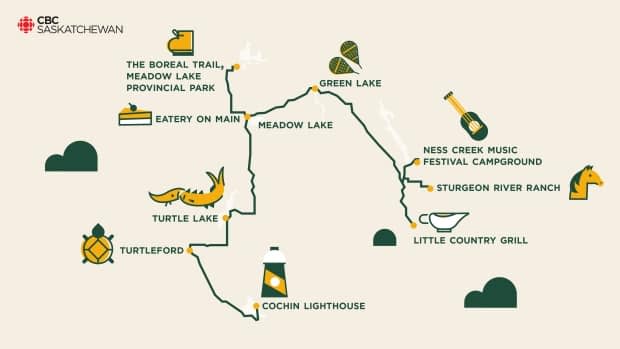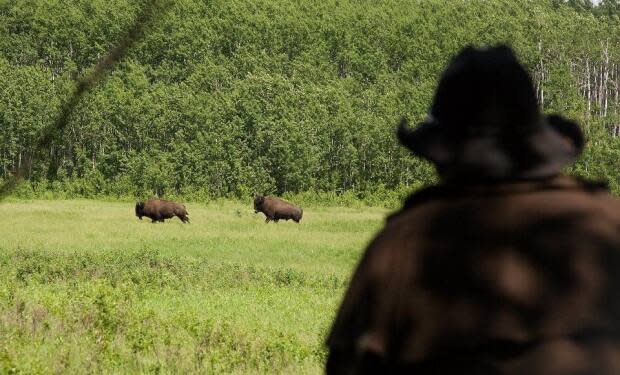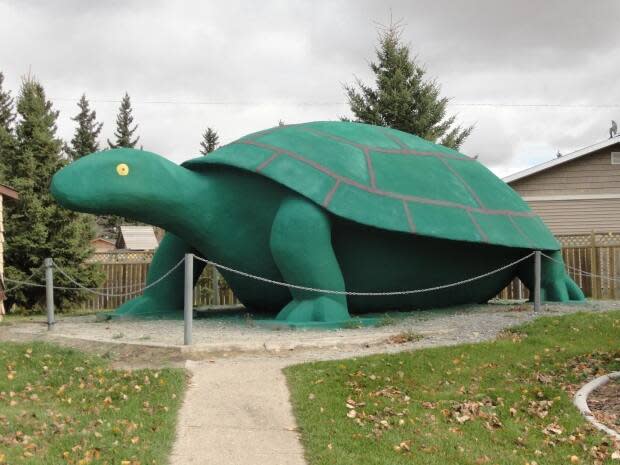Gateway to the north: Green Lake and region home to boreal forests, vibrant Métis pride
CBC's virtual road trip series Land of Living Stories explores the hidden gems across Saskatchewan. You can invite CBC's Laura Sciarpelletti to your community for a virtual tour. Visit cbc.ca/lovesk to pitch your ideas.
Rose Richardson speaks about the history of her people, the Métis, as someone who has spent years invested in the well-being and advocacy of that community.
Métis history is steeped in values — like giving back to the community, helping each other, and advocating for Métis culture — as well as traditional dress, music and beadwork, and land-based survival. Traditional medicines, community pride and a love of language are key parts of the past and present of the Métis in Saskatchewan.
Richardson, 79, has spent much of her life in the village of Green Lake in northwest Saskatchewan.
Green Lake, about 45 kilometres east of the city of Meadow Lake, is one of northwest Saskatchewan's oldest settlements — and it's predominantly Métis.
This land on the west side of the sprawling Prince Albert National Park is home to swaths of boreal forest. The Métis of the northwest region call the area, lush with nature, the gateway to Saskatchewan's north.
Richardson is a specialist in traditional Indigenous medicines and an educator. Originally from Meadow Lake, Richardson's family moved to Green Lake when she was a young girl. From an early age, she was taught to hide who she was.

"When I moved to Green Lake, most of the students [were] a mixture of French and English," Richardson said. "But we were taught by nuns and people were not allowed to talk Cree..... It was almost like it was an evil language."
"I didn't teach my kids to talk Cree because, to us, it was sort of a hidden language because we were not allowed to speak it."
Today, Richardson focuses on teaching Michif, the primary Métis language, to adults at the Gabriel Dumont Institute of Native Studies and Applied Research in Meadow Lake.
Green Lake is now home to many advocates, lawyers and educators.
"We are known as a really strong community in terms of being able to fight for our rights. We have a lot of people that are really well-spoken people," Richardson said.
"But there was a time in life where there was denial. People had to hide the fact that they were Métis because of the racism. One side of my family sort of denied it and said, 'We're French.' But you only have to look at me and you wouldn't have problems identifying me as a Native person."

For part of this Land of Living Stories road trip, we wanted to focus on Métis culture and, more specifically, Métis music made in Saskatchewan. Saskatchewan music historian Kaley Evans, of the Prairie to Pine music history website, guest-curated this playlist for us all. Listen to it here.
Richardson says this caused her to carry some shame with her as she grew into an adult.
"When I went to university, I figured I could never make it because I was Native. We were taught [in the Catholic Church] that girls didn't have to go to school because they should get married and raise a family," Richardson said.
"But I wanted to do something. I didn't want to be poor for the rest of my life. I ended up making that decision when I was about five years old. I never wanted my children to be poor. I never wanted them to face discrimination."

Richardson's daughter Angela Bishop has no shortage of words to describe her love for Green Lake and her respect for not only her mother, but her community.
"I had a culturally enriching experience," said Bishop of her upbringing, which she says literally took a village.
"I was very independent and strong-willed thanks to my parents, who were both independent and strong-willed and gave me a real strong sense of confidence and pride in who I am."

Today Bishop practises Indigenous law.
"I practise law in this area because of my wish to give back to my community. I'm working on several files where we're negotiating Métis self-government. Such is my commitment to reconciliation," said Bishop.
"I believe in promoting good relationships where everybody benefits. My experience, my choice, has been shaped by how I was raised."

Métis feather painting
The Métis are known for their beautiful beadwork, dancing and love of music. But for Lucille Scott, it's all about painting.
Scott is a Métis artist who lives in Canwood, about 130 kilometres south of Green Lake. She paints beautiful scenes and memorials onto Canada goose feathers with acrylic paint. Those feathers are then placed into frames made out of old, weathered barn wood — a staple of iconic Saskatchewan landscapes today.
"I taught myself to envision what I'm going to put on that feather first. See it in my mind and then put it on that space," said Scott.

Scott most loves to paint animals, especially horses, grain elevators and Prairie scenes. She says her art is especially influenced by her Métis culture.
"My grandmother on my dad's side used to make paper flowers ... paper roses and sell them as wedding bouquets. She always did these these crafty things and I would watch her. And my grandmother on my mother's side was from the north and she did bead work. She did beautiful roses on her beadwork. They really inspired me, my two grandmothers."
Scott's work is often gifted to prominent public figures such as former Saskatchewan premier Brad Wall, Premier Scott Moe and National Chief of the Assembly of First Nations Perry Bellegarde.
One of Scott's painted feathers was recently gifted to Tristen Durocher, the young Métis man who camped in a teepee near the legislative building in Regina last year to raise awareness about suicide in the province.
"I enjoy it because when I do my feather paintings, I put good energy into that. And I'm hoping that that good energy goes onto that person who the feather has been gifted to."
Eatery on Main, Meadow Lake
To the west, in the city of Meadow Lake, Kassidy Dunsing works as the owner and operator of the restaurant, café and bakery Eatery On Main.
Dunsing took over the restaurant in 2018 after moving to Meadow Lake from nearby Turtle Lake.
"You feel very welcomed. A lot of people do move to Meadow Lake to work at our mills as they are the huge economy source here. So we have people coming from all over Canada to work and typically when they get here, people stay. We are [a] very small business-orientated community that does work together very well," said Dunsing.

Eatery On Main is known for its juicy in-house burgers and decadent and unique homemade cheesecakes. But Dunsing says the customers are pretty sweet themselves.
"We're super lucky to have a whole bunch of regular customers here at the eatery. Especially since COVID. We've had some really sincere customers in here that have decided every Friday night, [they're] ordering from the eatery. And we just know to expect them," Dunsing said.
Dunsing says the small businesses of Meadow Lake are special, but so is the nearby Meadow Lake Provincial Park — a huge perk for the locals.
She says the hiking trails are a big part of her weekly plans. Right now, visitors to the park will find that the trails have been turned into skiing trails for some wintertime fun.
Sturgeon River Ranch
The area in and around the town of Big River, 120 kilometres east of Meadow Lake, is perfect for hiking and horseback riding.
Take a short 30-kilometre drive out of Big River and you will come up on Sturgeon River Ranch, located on the west side of Prince Albert National Park. Staff take guests on long, rustic horseback rides on the park's trails.

The Sturgeon River is the boundary to the park, and the river is visible from ranch property.
"We're in the transition eco region of the boreal forest. And so this is basically the start of the boreal forest. As you head north, it's more forest before it gets in the glacial shield quite a ways north," said John Prosak, owner of Sturgeon River Ranch.
Wolves, deer, birds and black bears can be seen on these rides, but the bison are the biggest draw.
The wild plains bison herd in the park is Canada's only totally free-ranging herd of its kind within their historic habitat.
"When you do see them, they are a wild animal and they act like one. So they become alert and then they make a few grunts and alert the others. They all look at you and then take off into the bush run," Prosak said.
"It is awesome to hear them, see them every time, because they go crashing off through the bush and you can feel the rumble of their hooves. You can feel the earth shaking when the herd runs through the bush. You can hear trees snapping."
Riding along the Sturgeon River Valley with Prosak and his crew, guests can spot a mix of poplar trees, jack pine forest, birch and willows.
While many guests like to visit the ranch in the summer, wintertime on the trail is something special.
"Most people don't realize how awesome it is to ride in the winter. It's probably my favourite time of year to ride. One of the things is that it's so quiet. You feel like you can hear things for miles and miles and miles, 'cause there's not as many birds. There's just not as many sounds. And there's not as much foliage. There's no leaves to block the sound," Prosak said.
"You can also see a long ways because the leaves aren't on the trees, the grass isn't grown up in the bush. And when there's snow like this, you can see the moose and the deer and the elk and the bison from quite a far ways away."


Turtle Lake, Cochin
Turtleford, located 136 kilometres northeast of Meadow Lake, is the proud home of Ernie the Turtle — a massive roadside attraction that happens to be the biggest and friendliest turtle in Canada. Visitors can catch a glimpse along Highway 26.

Up by Turtle Lake, you can search for the infamous Turtle Lake Monster.
About once a year, someone claims to have had an encounter with what is sometimes described as a massive scaly beast. Local Cree legend says people who ventured into the monster's territory on Turtle Lake vanished without a trace.
Gord Sedgewick, a Saskatoon area biologist for the Ministry of Environment, worked in the Meadow Lake and Turtle Lake area for 20 years. He says he's been hearing about the Turtle Lake Monster for just as long.
"You've heard of the surgeon general? Well, this is the sturgeon general of monsters, I guess, because it's so old," Sedgewick said.
Visitors have insisted they've seen the monster, but Sedgewick says no pictures have ever conclusively proven its existence.
"We did a lot of live trout netting and surveys. And I can tell you that we never did catch the Turtle Lake Monster. But the Turtle Lake Monster will always likely always be with us. But please, for me, don't hurt it if you do catch the monster. If it is real."
Sedgewick says the sightings of the so-called Turtle Lake Monster might actually be sightings of an unusually large lake sturgeon, or a relic of prehistoric plesiosaurs.
But you never know ....
Meanwhile, 70 kilometres away in the resort village of Cochin, stands the only lighthouse in Saskatchewan.

This working lighthouse sits on the top of Pirot's Hill. It serves as a beacon for summertime boaters and people on snowmobiles in the wintertime.
Visitors get a workout by climbing the 153 steps to the top of the hill. The payoffs are expansive views of both Murray and Jackfish lakes, as well as the village and prairie farmland.
Cochin lighthouse may just be the perfect place to reflect on the beauty of the northwest — a land that spotlights Saskatchewan's nature and its diversity.

